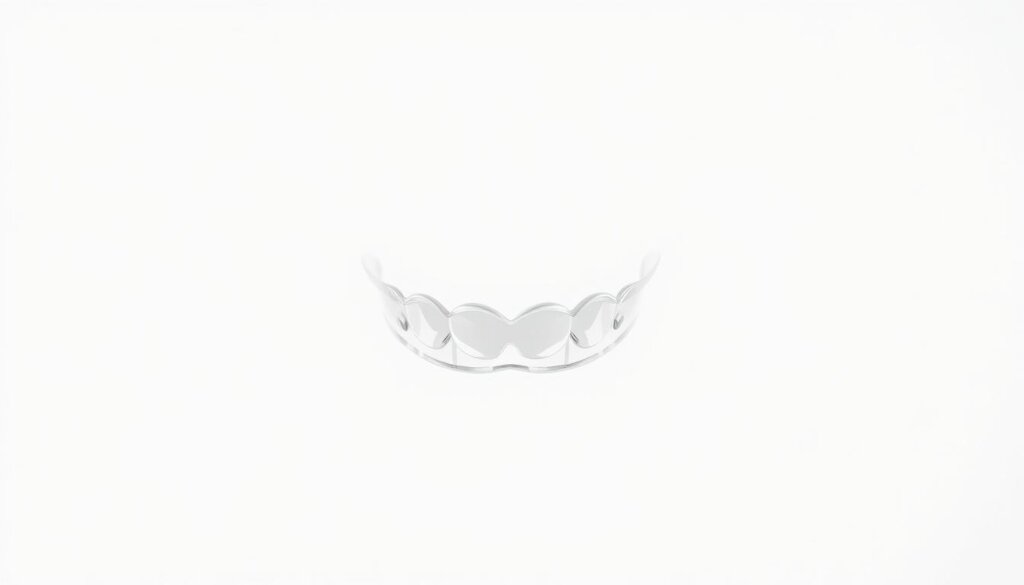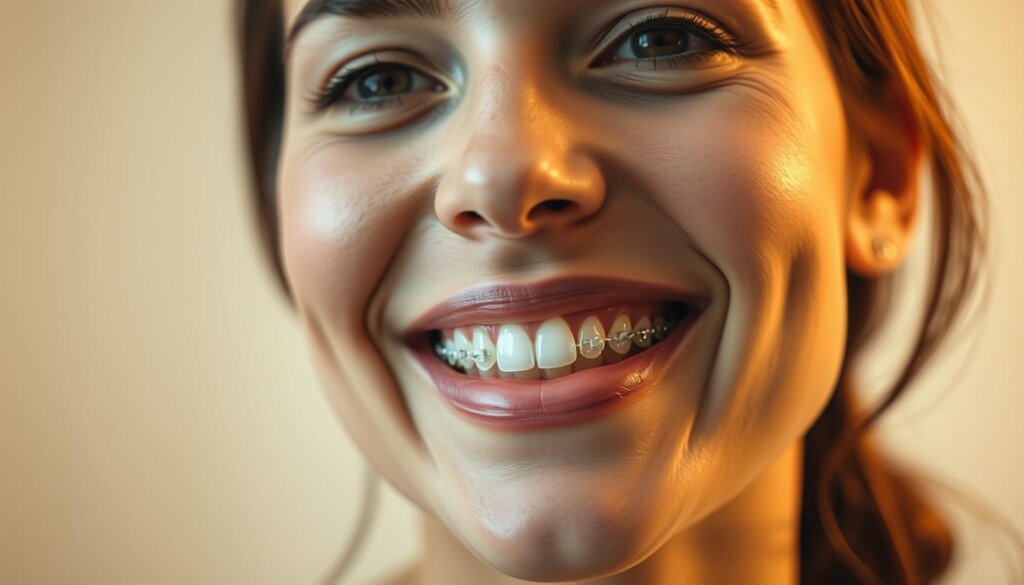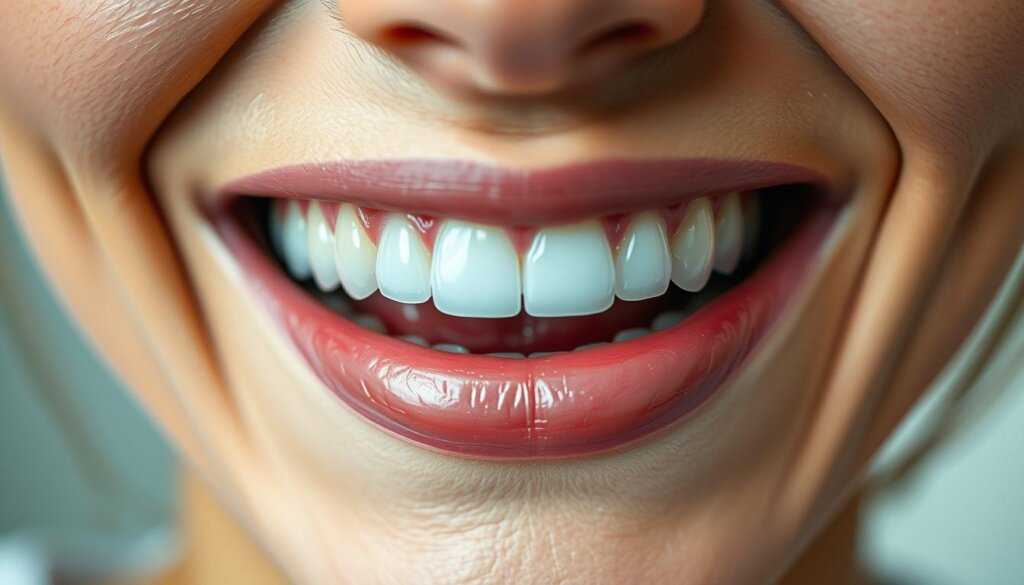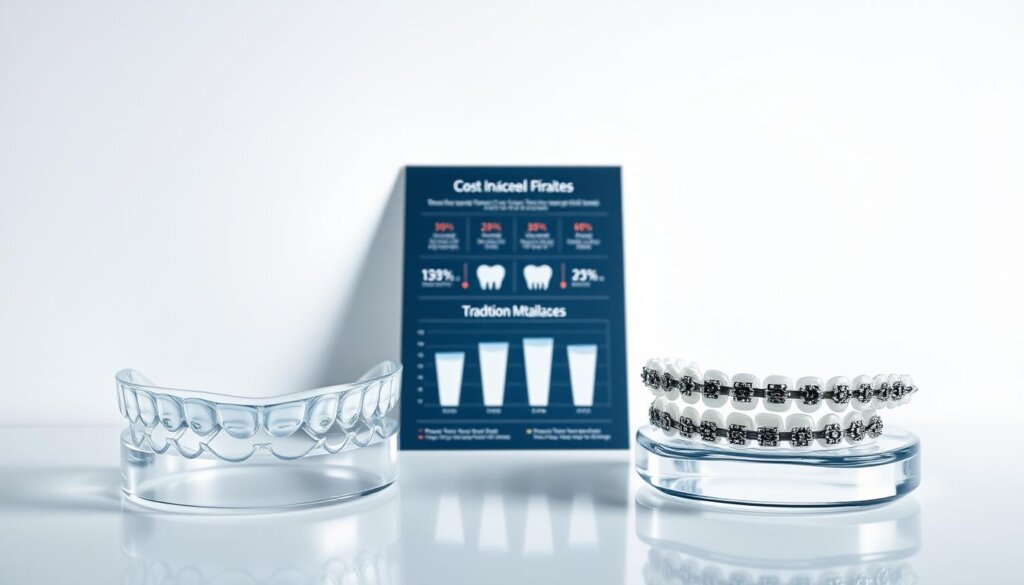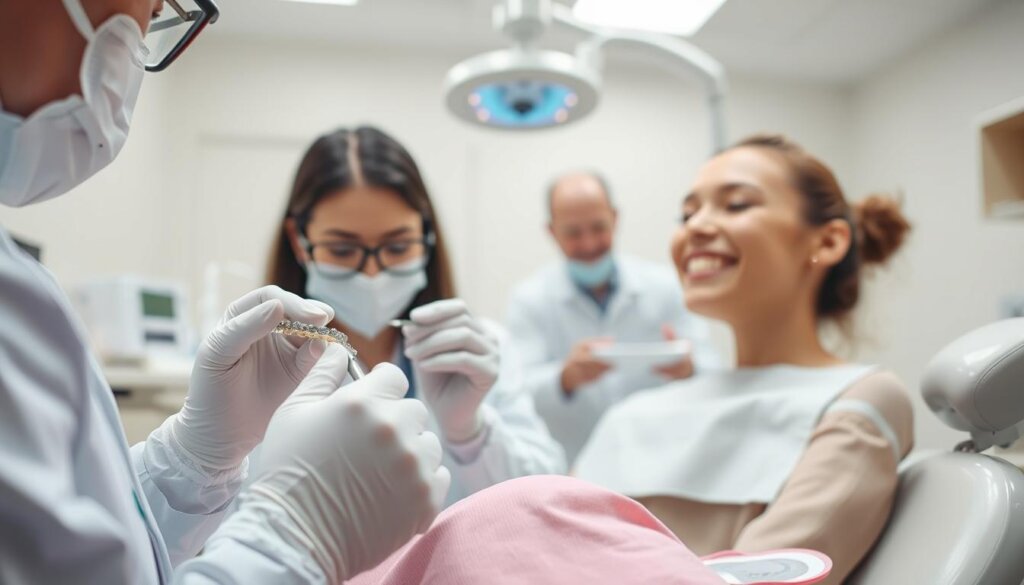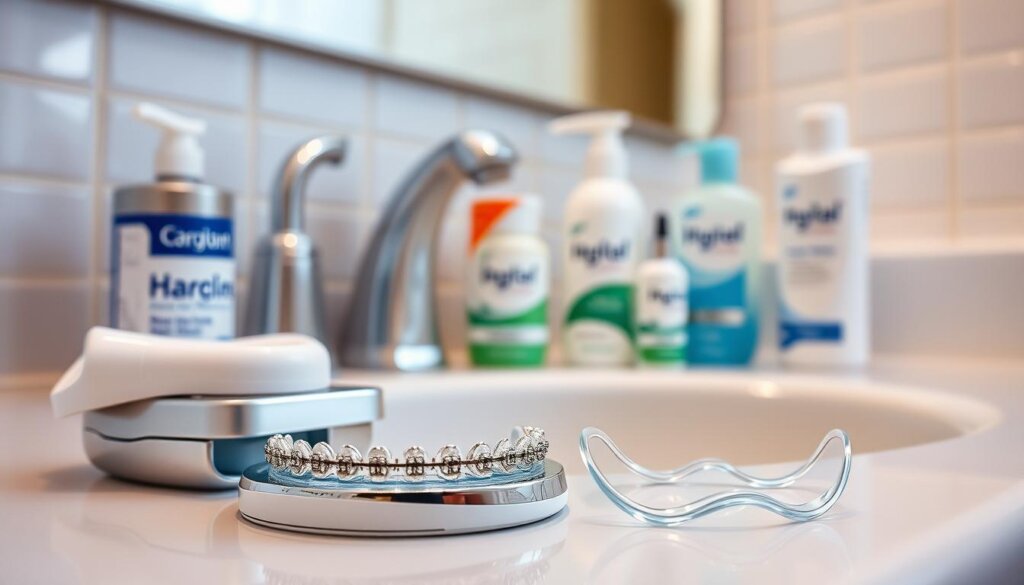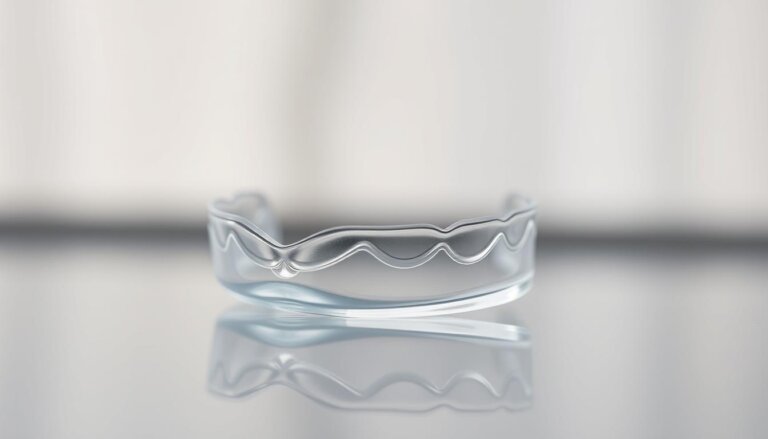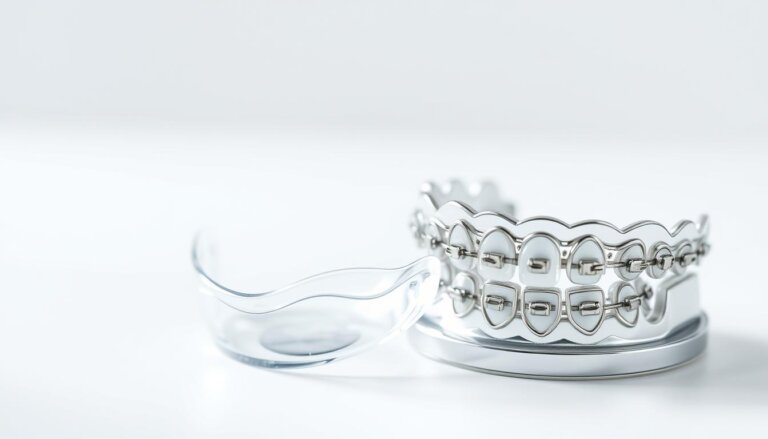Invisalign vs Traditional Braces: Key Differences
Every year, 4 million U.S. people start their journey with orthodontic treatments. They face a big decision: Invisalign versus traditional braces. Orthodontics, crucial for dental care, is always improving. Both methods are evolving to better meet what patients want and need.
Choosing between Invisalign and traditional braces isn’t just about looks. It affects the whole orthodontic experience and results. Traditional braces, known for fixing complex dental problems, have proven their effectiveness over time. Invisalign, on the other hand, offers stealth and ease. Though both aim to straighten teeth, they each have a unique way of doing it, maintenance needs, and effects on daily life.
Traditional braces work by using a system of braces and wires to slowly move teeth. Invisalign uses a set of clear, custom trays for alignment. Choosing between Invisalign vs traditional braces means considering your lifestyle, self-discipline, budget, and how you want your smile to look—all towards the goal of excellent orthodontic health.
Key Takeaways
- The choice between Invisalign and traditional braces is influenced by factors such as complexity of case, aesthetic concerns, and lifestyle needs.
- Traditional braces excel in correcting severe malocclusions and offer comprehensive treatment for a variety of orthodontic conditions.
- Invisalign provides a less noticeable alternative with the added benefit of removability, leading to easier maintenance and oral hygiene.
- The comparison of Invisalign and traditional braces is a nuanced decision that requires an understanding of the unique benefits and limitations of each.
- Patient engagement and discipline are crucial for the success of Invisalign due to the removable nature of the aligners.
- Cost considerations play a significant role in the choice between Invisalign versus traditional braces.
- Professional guidance is essential to determine the most suitable option for individual orthodontic goals and health.
Overview of Orthodontic Treatments
Orthodontics is a branch of dentistry that focuses on fixing crooked teeth and jaws. It not only makes you look better but also helps your mouth work better. People can choose from different orthodontic treatment options that match their lifestyle and needs, including the benefits of Invisalign over traditional braces.
It’s very important to have straight teeth for your overall dental health. Having your teeth well-aligned prevents gum diseases and makes biting easier. It also makes cleaning your teeth simpler, keeping them healthy for a long time.
What is Orthodontics?
Orthodontics is more than moving teeth around. It involves shaping the face and how it grows for both looks and function. Orthodontists use tools like braces and clear aligners to fix teeth and jaw issues.
Importance of Straightening Teeth
Having straight teeth is about more than a nice smile. Straight teeth wear down less, are easier to clean, and cut down on cavities and gum problems. They also help you chew better and speak more clearly, showing the wide importance of orthodontic treatment options.
Understanding Traditional Braces
Traditional braces have been a key method for fixing teeth and jaws. We’ll look into the parts of these braces and how they work to straighten teeth.
Components of Traditional Braces
Traditional braces work well because they have strong parts. Let’s check out the main parts:
- Metal Brackets: These are tiny squares glued to the front of each tooth. They help guide the movement of the teeth.
- Arch Wire: This is a thin metal wire that goes across the brackets. It puts pressure on the teeth to move them into place.
- rubber Bands (Elastics): For harder adjustments, these bands help line up the jaw and teeth better.
Together, these parts work to push the teeth into the right spot. This process fixes various dental problems.
How Traditional Braces Work
The way traditional braces straighten teeth is pretty detailed. Here are the main steps:
- Initial Placement: After making a plan, the braces are put on your teeth. This starts the journey to straighter teeth.
- Regular Adjustments: You’ll see your orthodontist regularly. They’ll adjust the wires to keep your teeth moving correctly.
- Monitoring Progress: Your orthodontist will keep an eye on how things are going and adjust the braces as needed.
This careful and controlled method is why traditional braces are great at fixing tough teeth problems, outperforming other options.
Exploring Invisalign
In the world of teeth straightening, Invisalign is a big step forward. It uses the latest technology with designs focused on the user. This method is not only nicer to look at than regular braces but also uses cool 3D imaging technology.
What is Invisalign? It’s a new way to make teeth straight with custom-made aligners. These aligners are comfy and clear. They’re made from a special plastic made just for Invisalign to slowly move teeth into the right spot.
The Invisalign treatment process begins with scanning the mouth using advanced 3D images. This scan gives a detailed digital look at the teeth. Based on this, a customized treatment plan is made. Then, a set of unique aligners is made. Each one is worn for two weeks before moving to the next one.
One big plus of Invisalign clear aligners is you can take them out. You can remove them when eating or cleaning your teeth. This makes life easier and less interrupted than with fixed braces. Also, because they’re clear and fit well, they’re hardly noticeable and comfy.
Getting a nice smile with Invisalign is watched closely by dental pros. They check on the aligner treatment’s progress at regular times. This personal check-up makes sure everything’s going as planned. It helps make the treatment successful.
In summary, Invisalign uses cool 3D tech to make a teeth-straightening option that works well and looks good. It’s an excellent choice for those wanting a less obvious, more comfy way to straighten teeth.
Key Differences in Appearance
When looking at how different orthodontic treatments look, we see a big difference between traditional braces and Invisalign. This greatly influences which treatment people choose.
The invisibility of Invisalign is its biggest selling point. These clear aligners are hardly noticeable, making them a popular choice. Adults and teens who care a lot about how they look prefer Invisalign. It lets them avoid embarrassment by keeping their smile looking natural while getting treatment.
In contrast, traditional braces, even with options like ceramic or behind-the-teeth styles, are still more visible. This fact plays a big role when people decide between Invisalign and braces. Many choose based on how noticeable the treatment is.
It’s important for patients to understand these differences. The choice between Invisalign and braces isn’t just about how they work. It’s also about how they look, which is becoming more important in orthodontic care.
- Clear aligners are nearly invisible, making them ideal for those who don’t want their treatment to be noticeable.
- Traditional braces are stronger but more visible, which can impact the wearer’s self-esteem and daily life.
Ultimately, patient preference in orthodontic treatment is shifting towards options that are not only effective but also discreet. This shows how much appearance matters in making treatment decisions.
Comfort and Fit
Both traditional braces and Invisalign have improved a lot to give you a great smile. Comfort with Invisalign is often seen as a big plus compared to braces. We’ll look into why people say this by comparing their comfort levels.
Invisalign uses clear aligners that many find comfortable. They’re made from a smooth plastic that fits perfectly to your teeth, thanks to 3D scans. This perfect fit means they’re less likely to bother your gums and cheeks.
On the other hand, traditional braces have brackets and wires. These can make your mouth uneasy, especially after tightening. Even with newer, smoother brackets, the metal parts can still poke your mouth. That’s why people thinking about braces often consider Invisalign for a comfier fit.
Both braces and Invisalign aim to align your teeth, which can be uncomfortable. But, Invisalign is often seen as more comfortable for daily wear. This makes Invisalign a top choice for those wanting an effective, yet easy way to a better smile.
Treatment Duration
Choosing between Invisalign and braces involves considering how long the treatment will last. Both options have different timelines that depend on the patient’s dental issues and how well they follow the treatment plan.
Invisalign treatment duration usually lasts between 12 to 18 months. However, this depends on the patient wearing the aligners for 22 hours daily and going to regular check-ups. Invisalign’s approach to moving teeth and its flexibility mean patients don’t need to see their dentist as often.
On the other hand, braces treatment timeframe can take from 18 months up to 3 years. The length of this treatment mainly rests on how severe the dental issues are and the type of braces. Braces need more frequent visits for adjustments, making the treatment last longer.
Knowing the differences in treatment times for Invisalign and braces is crucial. It shows a key difference between the two. How closely a patient follows their treatment plan greatly affects how long the treatment will take and its success.
Lifestyle Considerations
Choosing between traditional braces and Invisalign is more than about looks. It’s a big lifestyle choice. How they fit with daily life, like eating and cleaning your teeth, is key to picking the right one for you.
One of the top perks of Invisalign is eating with ease. You can remove Invisalign aligners before eating. So, you can enjoy any food you like without stress. This makes meals more enjoyable and cleaning the aligners simple, since there’s nothing for food to get stuck in.
Eating with traditional braces isn’t as easy. They have brackets and wires that stay on your teeth. This means you have to skip foods that could damage the braces. Avoiding these foods can change how you eat. It can also mean unexpected visits to the orthodontist if something breaks, which is a hassle and can be expensive.
Cleaning your teeth is also different with each option. With traditional braces, brushing and flossing take more effort. You need tools like threader floss and brushes for braces to get everything clean.
But you can take Invisalign out to clean it. This makes it simple to keep the aligners and your teeth clean. So, people often have better oral health with Invisalign than with braces.
When judging the benefits and drawbacks, these lifestyle factors are crucial. Being able to eat easily, clean your teeth quickly, and have a less noticeable treatment option make many people choose Invisalign. They prefer its convenience and benefits during their orthodontic treatment.
Effectiveness and Efficiency
Understanding the strengths of Invisalign versus traditional braces is key. Each system is designed for different dental needs. We’ll look at how both options work for various orthodontic situations.
For complex dental issues, traditional braces are often the go-to choice. They use metal wires and brackets to apply strong forces. This makes them great for severe problems like bad bite or crowded teeth. Traditional braces are known for precise and long-lasting results in complicated cases.
In cases needing moderate alignment, Invisalign stands out. It uses clear, custom aligners that are barely visible. Patients wear each aligner for two weeks, slowly moving teeth. Invisalign is also removable, making eating and brushing easier, affecting daily life less.
- Intricate Adjustments: Traditional braces excel in correcting tough dental issues.
- Mild to Moderate Corrections: Invisalign offers a comfortable and discreet way to straighten teeth with less severity.
The choice between Invisalign and traditional braces depends on the patient’s needs, the desired results, and lifestyle fit. Invisalign technology is improving, but traditional braces are still best for very complex cases.
Cost Comparison
When it comes to orthodontic treatment, it’s crucial to know the costs involved. This look at Invisalign versus traditional braces costs helps patients choose based on their budget and needs.
Orthodontic treatments vary in price for many reasons. These include how complex a patient’s dental needs are, where they live, and how long treatment takes. Let’s explore the costs for both traditional braces and Invisalign.
| Treatment Type | Average Cost |
|---|---|
| Traditional Braces | $4,500 – $8,000 |
| Invisalign | Up to $9,000 |
Traditional braces cost generally falls between $4,500 and $8,000. These prices cover everything from getting them put on to the adjustments you’ll need later.
On the flip side, the cost of Invisalign can go up to $9,000. This pays for the tech that makes them nearly invisible and easy to take out. The final price changes based on how many sets of aligners you need.
The Invisalign vs traditional braces price comparison shows that Invisalign might seem pricier at first. But, the total cost can match up when you consider how complex the treatment is and any extra adjustments after.
In the end, patients should weigh their cosmetic wants and how much they can spend. This helps ensure they pick the option that’s right for their life and wallet.
Follow-Up and Adjustments
Orthodontic adjustments are key in the comparison of Invisalign and traditional braces. These treatments both aim to improve your smile and dental health. Yet, how they check progress and adjust the treatments varies a lot.
For traditional braces, you’ll need to see your orthodontist often. About every four to six weeks, you’ll get manual adjustments to your braces. This is how braces steadily fix your dental issues, which is crucial for the process.
Invisalign follow-up visits, however, happen less often. Invisalign uses custom aligners that you change every two weeks. Since it doesn’t need manual adjustments often, you only check in with your orthodontist every six to eight weeks. This is to track your progress and make any necessary changes.
| Treatment | Adjustment Frequency | Progress Tracking |
|---|---|---|
| Traditional Braces | Every 4-6 weeks | Manual adjustments during visits |
| Invisalign | Every 6-8 weeks | Check-ups and new aligners |
The easy scheduling and less frequent visits with Invisalign follow-up are ideal for many. But, regular visits for traditional braces adjustments offer constant support from your dentist. This ongoing help can reassure you that your treatment is working.
When considering comparison of Invisalign and traditional braces, think about more than looks and comfort. It’s important to also think about the different schedules for visits and adjustments. These differences will greatly impact your treatment experience and how happy you are with the outcome.
Age Suitability
Choosing the right orthodontic treatment depends on a person’s age and their oral growth. Understanding whether traditional braces or Invisalign fits best is crucial. This knowledge helps identify the optimal orthodontic choice for different age brackets.
Traditional braces prove their versatility by being appropriate for a wide range of ages, from children to adults, thus covering a broad spectrum of orthodontic needs.
Teenagers and adults usually prefer Invisalign over braces. They like its low visibility and flexibility. Specifically, they’re ideal for those wanting a less noticeable way to straighten teeth.
Traditional braces age suitability often targets younger individuals. Metal braces work well for them because they handle complex dental issues seen in youth. They’re great for major adjustments.
Meanwhile, Invisalign candidates are generally older teens and adults. They must commit to wearing the aligners almost all day. This method is less visible and more comfortable. Yet, it needs strong discipline to follow through.
So, while braces work well for all ages, Invisalign is best for those looking for subtle and convenient treatment. It stands out as the optimal orthodontic choice for grown-ups and older teens.
Impact on Daily Life
Orthodontic treatments change how people interact and live their lives every day. The social impact of orthodontic treatments is big. It changes a lot between traditional braces and Invisalign. This change impacts how confident and comfortable people feel.
Living with braces means adjusting in many ways, including how you feel around others. Metal braces can make people shy, especially when talking or taking photos. But, wearing braces shows you’re committed to looking and feeling better, despite the short-term hassle.
On the other hand, Invisalign advantages in social settings stand out a lot. These clear aligners are barely seen. This means people can hang out without worrying about how their braces look. Invisalign keeps your smile looking natural. It boosts or keeps your confidence high in social situations.
These everyday social impacts are important when deciding on orthodontic care. Choosing between visible braces or the less noticeable Invisalign depends on what you prefer and need in your life.
How your teeth look can really change how you view social situations. People choose braces or Invisalign based on what’s important to them. They think about their lifestyle and how they interact with others.
Maintenance and Care
Braces and Invisalign need different care routines. It’s important to follow these routines to keep them working well.
Cleaning Traditional Braces
Braces need effort to clean because they don’t come off. You must use special tools like interdental brushes and water flossers. These tools help clean around the brackets and wires.
It’s also important to visit the orthodontist regularly. They provide deep cleaning and make any needed adjustments.
Cleaning Invisalign Aligners
Cleaning Invisalign aligners is easier since you can take them out. You should clean both the aligners and your teeth. Use a soft toothbrush and gentle cleaner for the aligners to avoid bacteria buildup.
| Care Aspect | Traditional Braces | Invisalign Aligners |
|---|---|---|
| Tools Required | Water flosser, interdental brush, orthodontic floss | Soft-bristled toothbrush, non-abrasive cleaner |
| Professional Maintenance | Regular adjustment appointments, professional cleanings | Occasional check-ups for fit and progress |
| Home Care Frequency | After every meal and snack | Twice daily and after meals |
Potential Risks and Discomfort
Orthodontic treatments like traditional braces or Invisalign come with risks and discomfort. This is a big worry for many people thinking about their options. It’s key to know the discomforts of both to make a good choice. Each method moves teeth into place differently, which changes how discomfort is felt.
Traditional braces can cause mouth sores and swollen gums. This is mainly from the metal parts that can poke the inside of your mouth. This shows a big downside of braces when it comes to comfort.
Invisalign, a newer option, generally causes less pain. However, the aligners still press on the teeth, which can be uncomfortable at first.
It helps to look at the pain from braces versus Invisalign over time. Both need getting used to, but the pain and discomfort differ a lot.
| Treatment | Type of Discomfort | Common Issues |
|---|---|---|
| Traditional Braces | Physical irritation | Mouth abrasions, gum inflammation |
| Invisalign | Pressure discomfort | Temporary pain during new aligner phases |
Both choices have their own issues and discomforts to think about. Talking to an expert orthodontist is wise. They can help decide what’s best for you based on what you can handle and your lifestyle.
Consultation and Recommendations
An initial Invisalign consultation is crucial for anyone thinking about this new way to straighten teeth. Just as important, those looking at traditional braces will benefit a lot from a detailed chat. These meetings are key to get orthodontic treatment advice that fits just for you.
At your consultation, you’ll go through a thorough check of your teeth. This includes pictures and maybe digital scans to map out your treatment accurately. Both Invisalign consultation and traditional braces aim to find what works best for you, your lifestyle, and your budget.
| Treatment Type | Focus Areas | Expected Outcome |
|---|---|---|
| Invisalign | Esthetic appearance, minimal visibility | Correct alignment with discretion |
| Traditional Braces | Comprehensive correction capabilities | Effective alignment for complex cases |
Deciding between Invisalign and traditional braces involves several things. Think about how complex your dental issues are, how much you want people to see your treatment, and how you prefer to take care of it. An orthodontist’s traditional braces recommendations or an Invisalign consultation will give you detailed info. This helps you choose wisely with expert, tailored orthodontic treatment advice.
Conclusion: Making Your Choice
Choosing orthodontic treatment is a big decision with lasting effects on oral health and happiness. When picking between traditional braces and Invisalign, there are many factors to consider. These include how well the treatment works, looks, cost, how long it will take, and if it suits your age and dental health. Each aspect is crucial in shaping your choice to match your dental health goals and way of life.
Factors to Consider for Your Decision
Deciding between Invisalign or braces means looking at how each fits into your daily routine and fixes your orthodontic issues. The look of Invisalign might be more appealing to some because it’s less noticeable. Others might choose braces due to their cost and how long treatment takes. Remember, the aim is not just a better-looking smile but also making sure your teeth and gums are healthy.
The Importance of Professional Guidance
Getting advice from an orthodontist is a key part of making this choice. They know the details of each treatment option and will recommend what’s best for your oral health and desired results. Professional guidance helps you make a choice that is well-informed. The main goal is achieving a healthy, functioning, and confident smile with a treatment plan made just for you, supported by the expertise of orthodontic professionals.

